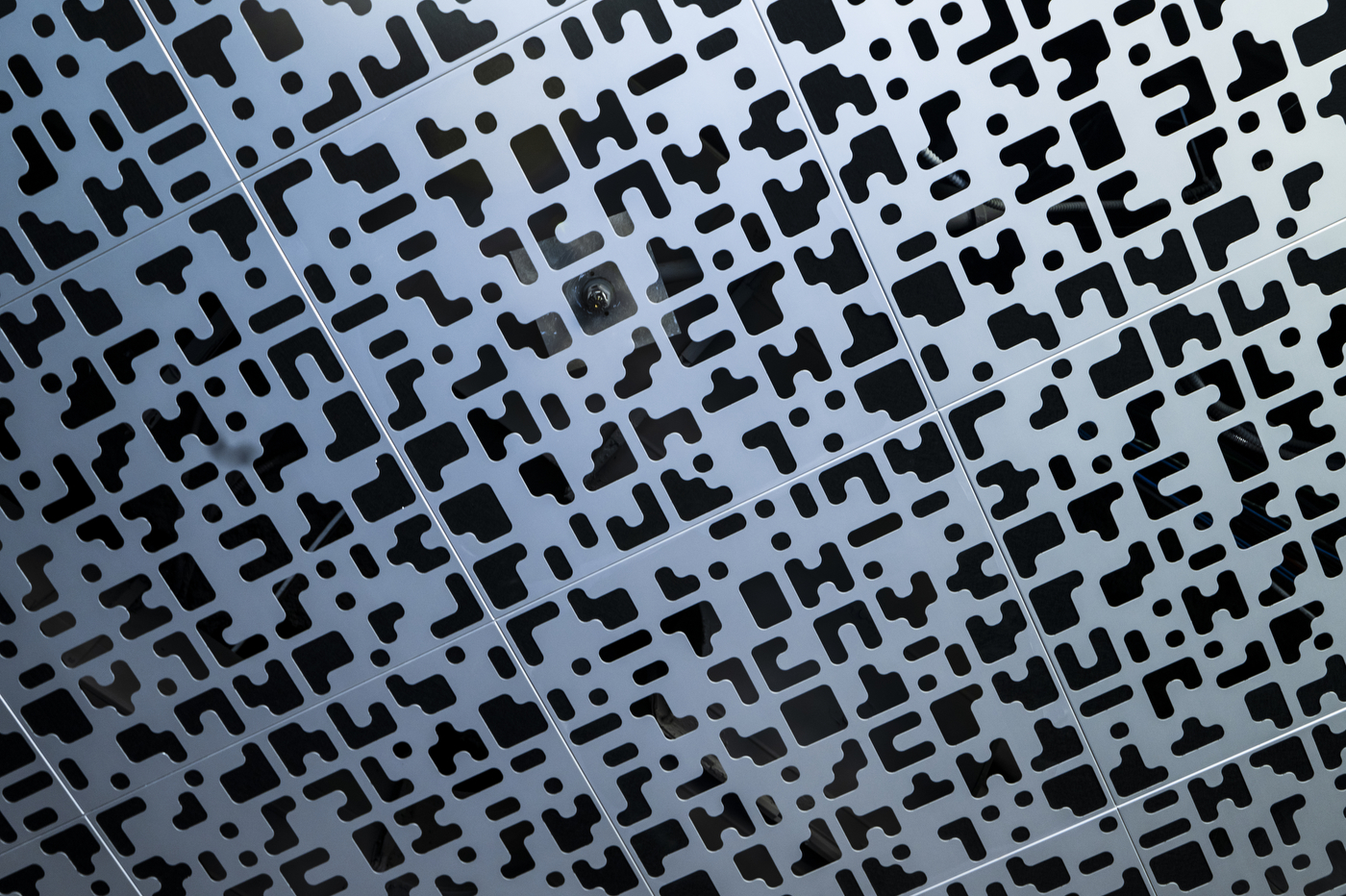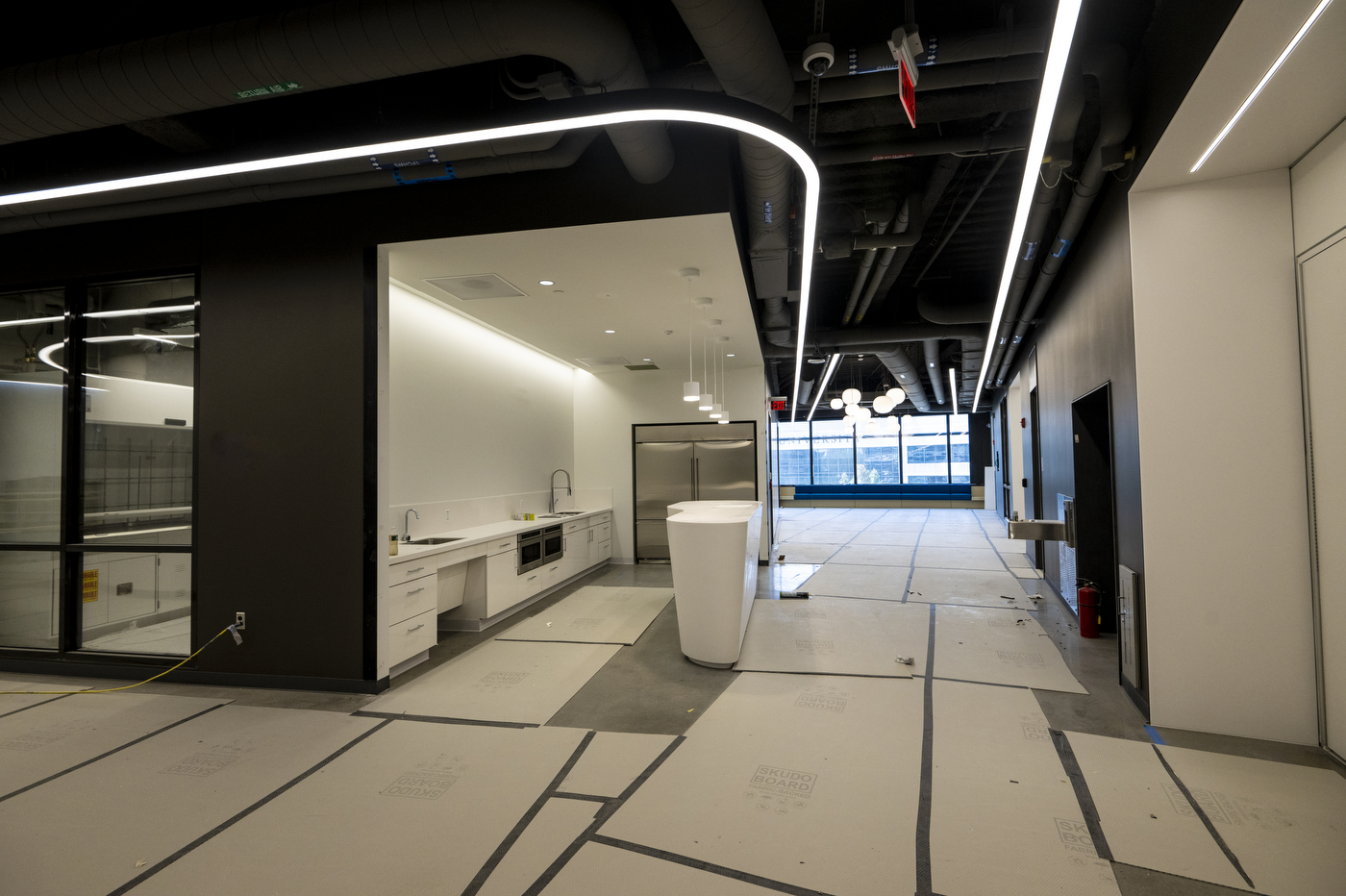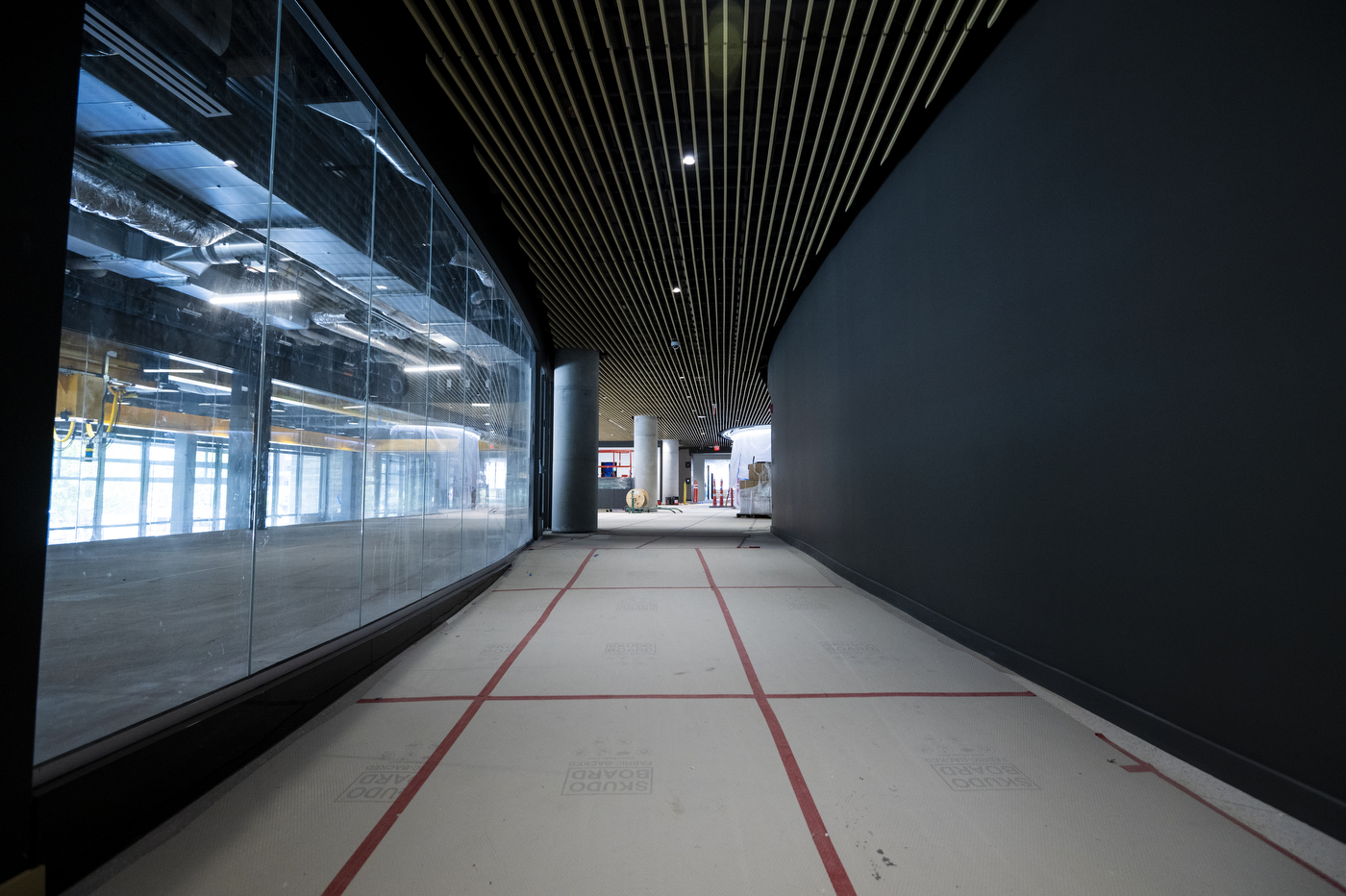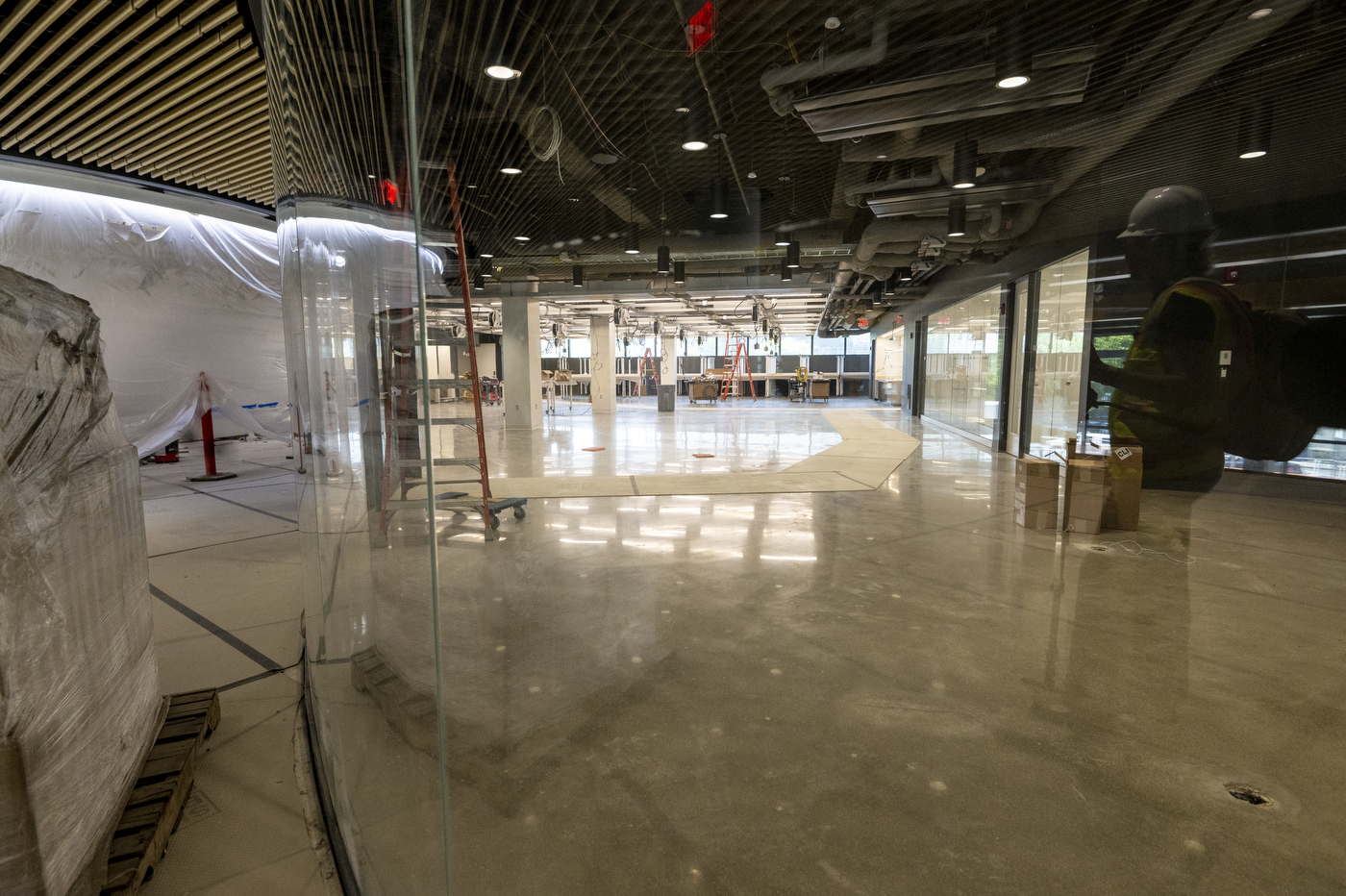Take a look inside Northeastern’s new EXP building as it nears completion. It will push the boundaries of knowledge and discovery

The display screens are getting mounted. A laser-cut metal ceiling is installed. The filtered fume hoods await students’ chemistry experiments.
As the clock ticks down to a September opening, the finishing touches are being added to EXP—Northeastern University’s new eight-story, 357,000-square-foot facility that will further the horizons of science, engineering, teaching and creating.
“The student experience is taking a monumental leap forward with the opening of this facility and I can’t wait to witness the transformative impact it will have,” says David Madigan, provost and senior vice president for academic affairs at Northeastern. “It will empower our students to unleash their full potential and immerse themselves in real-world learning, scientific exploration and interdisciplinary collaboration.”



EXP rises next to the complementary Interdisciplinary Science and Engineering Complex, and it is wrapped in distinctive, horizontal stainless-steel “fins.”
It offers eight floors of occupiable space, including a top-floor executive area; a floor primarily dedicated to computational research, or research that uses computing systems to apply mathematical models for solving problems; four floors of teaching and academic research labs, 15,000 square feet of makerspace throughout the building; a cafe and “Ideation” space overlooking a ground-floor robotics area, and much, much more.
“Northeastern University’s new EXP will be a unique and powerful science and engineering research, and learning facility,” says Bob Schaeffner, the principal-in-charge of the project for the architecture firm Payette.
Payette also designed ISEC, which opened in 2017.
“As a complement to the ISEC building next door, it completes a former surface parking lot with wonderfully expressive buildings in a vibrant urban landscape,” Schaeffner says. “EXP has its own dramatic stainless steel exterior which harmonizes with ISEC in creating an iconic science and engineering hub.”
EXP’s spaces were just taking shape, the last time that Northeastern Global News was inside the building.
What a difference a year makes.





“We’re in the final sprint of the marathon,” says Jacqueline Valencia, a senior capital project manager at the university.
Madigan says EXP is more than just a building.
“It is a testament to our continued dedication to fostering a vibrant ecosystem of scientific exploration and interdisciplinary collaboration,” he says.
Madigan says the state-of-the-art facility will support pushing the boundaries of knowledge and discovery.
“It will inspire our students, faculty and researchers to embark on extraordinary scientific journeys that will create lasting impact. Walking through the space you can feel the endless possibilities it holds, and I am excited to witness the groundbreaking work that will emerge within its walls, and eventually shared with the world.”
The tour begins at the top, with the eighth-floor executive area. The lobby is decorated with a laser-cut metal ceiling and includes a skylight that floods light down on the spiral staircase rising five floors through the core of the building. A new location for the Faculty Club will expand its capacity from roughly 70 to 100 seats and has access to a three-season, rooftop deck. A double-height multifunction room provides a space for meetings, gallery space and additional dining space—in fact, one wall encompasses a huge metal-patina, vertical-lift door to expand the space into the lobby when necessary.
Floor seven offers a good example of space for computational research, with lab “neighborhoods.” In addition, the public corridor that accesses those labs includes seating clustered around large monitors that students can use for studying.
Floors four and three provided a good example of research labs and teaching labs. All labs in the building are wet-lab capable—meaning that they can be used to manipulate liquids, biological materials and chemicals—but floors five through seven contain labs focused more on research, while floor four has both teaching labs and research labs, and floor three is all teaching labs.



The building’s spaces in general are designed to be adaptable and flexible as different research and scientific needs arise.
“Research groups are clustered in interdisciplinary neighborhoods on the upper floors that pinwheel around a dynamic central stairway,” Schaeffner says. “The highly flexible laboratory spaces are readily visible from the central space and students are offered many opportunities to study and interact between the neighborhoods.”
A lab on floor three provides a good example of a future home for Chemistry 101. You first enter a coat room with individual lockers for students and access to a shared preparatory lab. The coat rooms enter into the main lab spaces, which accommodate two students per fume hood.




Floor two is a more public floor dominated by three main elements: four large classrooms; a large makerspace with adjacent workshops; and a public cafe with seating in an “Ideation” space. During the tour, workers were installing the latest digital technology into the classrooms, two of which have movable glass walls so classrooms can be combined to make larger spaces. The main makerspace is open concept with rolling tables, and it is the space for everything from sewing to laser cutting. Specialty rooms like a wood shop and a 3-D printing room open off the main makerspace.
Meanwhile, the cafe and “Ideation” space looks into the makerspace as well as over a double-height space for robotics. Look closely and you’ll see screws and washers and other small metal hardware embedded in the flooring, a nod to the makerspace. This floor also opens onto the pedestrian bridge that connects EXP to the central part of campus and to ISEC.
The robotics space on the ground floor, however, is perhaps the main visual draw from the second floor, with its 12-ton, ceiling-mounted crane for moving robots. The street-facing wall is all glass—permitting curious pedestrians another view of the space—and this wall includes a glass garage door that can be opened to accommodate deliveries or vehicles, if necessary.


The front entrance lobby, where a large staircase leads up to the cafe and Ideation space, also overlooks the robotics area. The building will be open to the public from 5:45 a.m. to 11 p.m., and those wanting access overnight will have to tap in with their Husky card.
Valencia said that the final touches in construction are happening now and workers hope to furnish and move machines into the building in August so it is ready for September.
Cyrus Moulton is a Northeastern Global News reporter. Email him at c.moulton@northeastern.edu. Follow him on Twitter @MoultonCyrus.






